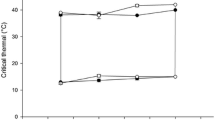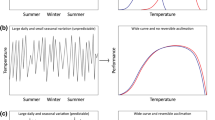Summary
Mytilus edulis adapted to cyclic temperatures by reducing the amplitude of response of oxygen consumption and filtration rate over a period of approximately two weeks, and thereby increasing their independence of temperature within the range of the fluctuating regime. When acclimated to cyclic temperature regimes within the range from 6 to 20°C, the metabolic and feeding rates, measured at different temperatures in the cycle, were not significantly different from the adapted response to equivalent constant temperatures.
Physiological adaptation ofMytilus edulis to different thermal environments was reflected in their metabolic and feeding rate-temperature curves. Animals subjected to marked diel fluctuations in environmental temperature showed an appropriate region of temperature-independence, whereas animals from a population not experiencing large diel temperature fluctuations showed no region of temperature-independence.
In a fluctuating thermal environment which extended above the normal environmental maxima, respiratory adaptation occurred at higher temperatures than was possible in a constant thermal environment. The feeding rate was also maintained at higher temperatures in a cyclic regime than was possible under constant thermal conditions. This represented a shortterm extension of the zone of activity in a fluctuating thermal environment. The net result of these physiological responses to high cyclic and constant temperatures has been assessed in terms of ‘scope for growth’. Animals acclimated to cyclic temperatures between 21 and 29°C had a higher scope for growth at 29°C and were less severely stressed than those maintained at the constant temperature of 29°C.
Similar content being viewed by others
References
Bayne, B.L.: Oxygen consumption by three species of lamellibranch mollusc in declining ambient oxygen tension. Comp. Biochem. Physiol.40A, 955–970 (1971)
Bayne, B.L.: Marine Mussels: Their physiology and ecology. Cambridge: Cambridge University Press, in press 1976
Bayne, B.L., Thompson, R.J., Widdows, J.: Some effects of temperature and food on the rate of oxygen consumption byMytilus edulis L. In: Effects of temperature on ectothermic organisms (ed. W. Wieser) p. 181–193. Berlin-Heidelberg-New York: Springer 1973
Conover, R.J.: Assimilation of organic matter by zooplankton. Limnol. Oceanogr.11, 338–345 (1966)
Costlow, J.D., Bookhout, C.G.: The effect of cyclic temperatures on larval development in the mud-crabRhithropanopeus harrisii. In: Fourth European Marine Biology Symposium (ed. D.J. Crisp), p. 211–220. Cambridge: Cambridge University Press 1971
Feldmeth, C.R., Stone, E.A., Brown, J.H.: An increased scope for thermal tolerance upon acclimating pupfish (Cyprinodon) to cycling temperatures. J. comp. Physiol.89, 39–44 (1974)
Fry, F.E.J.: Effects of the environment on animal activity. Univ. Toronto Stud. Biol. Ser. 55 (Publs. Ont. Fish. Res. Lab. 68) 1–62 (1947)
Gabbott, P.A., Bayne, B.L.: Biochemical effects of temperature and nutritive stress onMytilus edulis L. J. mar. biol. Ass. U.K.53, 269–286 (1973)
Otto, R.G.: The effects of acclimation of cyclic thermal regimes on heat tolerance of the Western Mosquitofish. Trans. Amer. Fish. Soc.103, 331–335 (1974)
Warren, C.E., Davis, G.E.: Laboratory studies on the feeding, bioenergetics and growth of fish. In: The biological basis of freshwater fish production (ed. S.D. Gerking), p. 175–214. Oxford: Blackwell 1967
Widdows, J.: Effect of temperature and food on the heart beat, ventilation rate and oxygen uptake ofMytilus edulis. Mar. Biol.20, 269–276 (1973)
Widdows, J., Bayne, B.L.: Temperature acclimation ofMytilus edulis with reference to its energy budget. J. mar. biol. Ass. U.K.51, 827–843 (1971)
Winberg, G.G.: Rate of metabolism and food requirements of fishes. Nauchn. Trudy belorussk. gos. Univ. V.I. Lenina (Fish. Res. Bd. Can. Transl. Ser. No. 194) (1956)
Author information
Authors and Affiliations
Rights and permissions
About this article
Cite this article
Widdows, J. Physiological adaptation ofMytilus edulis to cyclic temperatures. J Comp Physiol B 105, 115–128 (1976). https://doi.org/10.1007/BF00691115
Received:
Issue Date:
DOI: https://doi.org/10.1007/BF00691115




